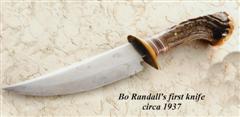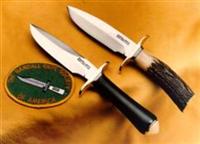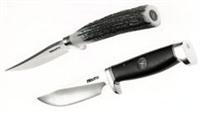I had a lengthy discussion with a gentleman on another forum that I think is important enough to share with you guys. His name is Jack Williams and he goes by "Jacknola". He hasn't been involved with Randalls that long, but he has taken the power of observation and focused it on the differentiating attributes of Heiser vs. Johnson BB sheaths carrying the vertical Randall logo (Something that's hard to believe some of us more seasoned collectors haven't done before!) . Two distinct "tell's have emerged:
1. The orientation of the (vertical) stamp.
2. The placement of the male keeper snap on the sheath.
We need to start out by making sure these features are indeed associated with a specific manufacturer. In the case of Heiser, we have the ebay auction photo as a control. From the 1st photo, we can see that the vertical 12-9 logo is positioned in what Jack calls "West-facing". In other words you have to be "West" of the vertical logo in order to have the printing to read right-side-up:

In the next photo, you can easily see that the male retainer snaps are positioned in the center of the sheath.

In the case of Johnson, we don't have an absolute "known" Johnson BB sheath to use as a control, so we can take a mid-to-late 60's tight stitched plain button or "baby dot" sheath to use as a control for these attributes. Here's a pair of Johnson baby dot 1-7 sheaths with a diagonal keeper strap. Note that the male keeper is positioned on the far right side of the sheaths:

On the back side, you can see that the Randall logos are oriented "East-facing":

The litmus test as to whether or not these different features can used as a guideline to determine if a BB sheath with a Randall logo was made by Heiser or Johnson is whether or not the manufacturers were consistant in their orientation of the vertical logo and the placement of the male keeper.
From the Heiser side, do all sheaths that either have very early 60's provenance or blade grinds have the "West-facing" logos and middle of the sheath male keepers. So far, EVERY ONE of these that Jack or I have found do! Here are some examples:
1. Tom Clinton's pinned ebony Model 1-8 name and year 1960 etched (Top knife):

As you can see, the male keeper is positioned in the middle of the sheath.

As you can see, the vertical Randall logo is West-facing (Knife on the left).
2. Michael Mason's 4-6 with an ink marked sheath dated 3-11-61:

Note the male keeper is positioned in the middle of the sheath

Note the vertical Randall logo is oriented West-facing.
3. Bob Hunt's double hilt Model 3-7 on page 169 of his book Randall Military Models with a 1961 ink marked sheath:

It's hard to see, but the logo is West-facing. There is no photo of the front of the sheath.
4. There are some BB sheaths with Randall logos that are so early in the 60's that they still have a horizontal keeper. All these that I have found have the West-facing logo:


5. All of the very early 60's knives with shallow elongated choils that I have found have BB sheaths with West-facing logos and middle of the sheath male snaps. Here are a few examples:
Jack's Model 1-8:


My laminated brown Micarta 3-6:


My "original Recon":


On the flip side, EVERY mid to late 60's tight stitched rough back Johnson baby dot sheath I have or have seen carries the East-facing logo and diagonal keeper that is fastened at one of the far sides of the sheath! Other BB sheaths with the Randall logos that I know are not early 60's have East-facing logos and far edge keeper placements. The first order in Bo's journal for a 12-8 was February 6th, 1964. This is the only known 12-8 BB sheath. It has the East-facing logo and far side keeper placement:


With reagrd to the "horizontal" Randall logos: Every one of these that I've seen has the keeper placed in the middle of the sheath, which seems to be consistant with Heiser.
There may be a THIRD distinguishing feature! As I was going through my sheaths to photograph a few this morning, I noticed that all the West-facing logo / middle keeper placement sheaths had a "tooled ridge" on the edges:

While all the the East-facing logo / far side keeper placement sheaths had "rounded shoulders":
[img]
http://www.fototime.com/638C5DF67BF4E85/large.jpg[/img]
Then I took a look at my 50's Heiser sheaths and saw all of these had tooled edges:
[img]
http://www.fototime.com/490D4E60F818F77/large.jpg[/img]
I'm soliciting help from anyone who can contribute to what Jack calls his "
Heiser-Johnson brown button Grand Unification Theory" in terms of data points that either support it or contradict it. If we're going to have a Randall community-accepted method for distinguishing Heiser vs. Johnson BB sheaths, we need to have statistical probability on our side. If and when there is general acceptance, then we can start to narrow down the timeframe that Johnson got involved. I don't think there is any way to pinpoint it by knife attributes, as (1) There were varying quantities of Heiser sheaths in stock for different models at that time and (2) Some knives sat in inventory for a while before they were sold, but we should be able to get a pretty good idea. We might even be able to come up with a graphic timeline that looks something like this (Courtesy of Jack)
[img]
http://www.fototime.com/606D4BC0F8C50DC/orig.jpg[/img]
Thanks in advance for any help you can give.
Best,















